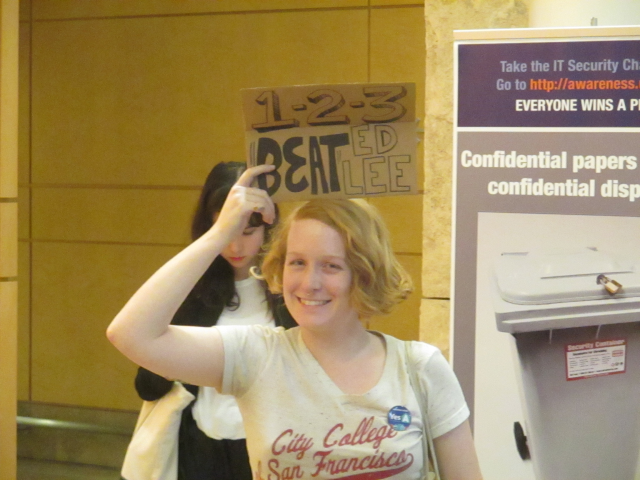The question that isn’t getting asked in this mayoral race. Plus: Remembering a deadly case of landlord arson from a much earlier era of gentrification in the Mission

By Tim Redmond
OCTOBER 12, 2015 – So I wasn’t happy with the only debate that San Francisco voters could see with all of the candidates present. Neither, I think, were most of the candidates.
And the more I think about it, the more I realize why.
Yeah, there were no questions about housing, which is the biggest issue in the city. But more than that, I think the question nobody is asking (including the Chron, which just wrote about Ed Lee’s first term) is the classic political issue:
Are San Franciscans better off than they were five years ago?
Or better put, are the people who lived in San Francisco five years ago better off today?
For the thousands who have been forced to leave the city, some of them dispersed to the winds, cut off from their communities, some of them commuting two hours or more each way to their jobs, the answer is pretty clear: No, they aren’t better off.
For the thousands who have managed to remain, but are much poorer because such a larger percentage of their income is going to rent,the answer is also clear: No, they aren’t better off.
For the nonprofit groups who have been displaced from mid-Market by the tech boom, and now have to pay more rent in a location less suitable for their clients, the answer is clear, too: No, they aren’t better off.
The mayor brags about his jobs policy, and says that when he took office the unemployment rate was above eight percent. Now it’s at around three percent. Hooray.
But there are two factors that were never discussed at the debate when Lee made his pitch. The first is the unproven, but likely reality that one of the reasons the unemployment rate has fallen is that unemployed people have been priced out of SF while tens of thousands of people have moved here from somewhere else to take jobs.
The other is that many of the jobs that have been created (outside of tech) don’t pay enough to allow someone to live here.
Enrico Moretti at Cal says that every tech job creates five more jobs; the mayor likes the sound of that. But most of those five are service-sector jobs. If you were living here five years ago and didn’t have a job, and were and are in a rent-controlled apartment, and you got a job serving the technorati, and you are still here by the grace of God and your landlord, then maybe you are better off. Except that you wake up every night worrying you are going to be evicted next – and that’s already happened to your friends and neighbors.
Oh, and your favorite cheap restaurant or dive bar is gone, and you can’t afford the place that replaced it.
Seriously: If we were able to poll people who lived her five years ago – whether they are still here or not – and asked if they were better off under Ed Lee, I think we’d get a picture of a city that is not doing better, not for all.
In fact, if you take the bottom three quintiles – that is, the lower 60 percent of the population by income – and compare the increased income that has come with the boom with the higher cost of living that’s associated with it – you’ll probably find the majority of those people doing worse.
Longtime homeowners, of course, are doing dandy – the value of their property keeps rising, while their property taxes never go up. But recent homebuyers are facing crippling mortgages (unless they are very rich), and others are completely price out of the market.
I don’t think the mayor fares well in that kind of analysis.
Tom Ammiano notes in this week’s Tim and Tom show that there’s only one – one – high school LGBT studies class in the entire country, and it’s at SF’s School of the Arts. There is no textbook, no high-school-level history of LGBT America. That seems like something the School Board ought to think about; why is LGBT Studies not part of the curriculum at every high school?
Most people in San Francisco don’t remember the Gartland Hotel Fire, but in the early 1980s, when I arrived here, it was still very much a part of local housing politics. The SRO on 16th and Valencia was torched in 1975, in a clear case of arson for profit, and the site was still an empty pit when I first rode the 22 Fillmore past it in 1981.
Now there’s a movie called “The Other Barrio,” loosely based on the fire, which killed 12 people, and a story by SF’s Poet Laureate Alejandro Murguia. It opens this week at the Brava Theater.
From the description:
As if ripped from today’s headlines reporting fires, evictions and protests in the streets, “The Other Barrio” follows housing inspector Roberto Morales as he investigates the suspicious circumstances of a fatal fire in a residential hotel in the Mission and finds himself face to face with murder in the streets, corruption at City Hall and the mysterious Sofia Nido, a beautiful but dangerous flame from his past.
With the dramatic SF cityscape as a backdrop and a nod to San Francisco film noirs of the past, The Other Barrio, takes viewers deep into neighborhoods seldom seen on film while addressing timely issues of gentrification and the displacement of low-income communities.
You can see it Friday, October 16th: 7 pm and 9:30 pm; Saturday, October 17th, 7 pm and 9:30 pm; Sunday, October 18th, 3:30 pm and 6 pm, and Thursday, October 22nd, 7:30 pm




